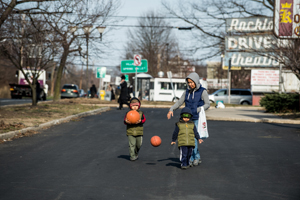 SPRING VALLEY, N.Y. — In just about any other community in the nation, last Thursday’s public meeting here set to feature opposing slates of candidates for the local school board would have measured as a routine event in the usually civil, if not downright boring, exercise of local politics.
SPRING VALLEY, N.Y. — In just about any other community in the nation, last Thursday’s public meeting here set to feature opposing slates of candidates for the local school board would have measured as a routine event in the usually civil, if not downright boring, exercise of local politics.
Local politics, though, in this collection of small, working-class communities, about 50 miles north of New York City, is anything but routine, or civil. It is a vicious scrum that has come to reflect deep religious and racial divides.
Next Tuesday’s election for seats to the East Ramapo Central School District’s board isn’t about politics in the traditional sense, pitting Democrats against Republicans or red state ideology against blue; it’s about the divisions between the black and Latino residents who see the public school system as a civic stepladder to a better life, and the Hasidim, a mystical religious sect, that sees it as a threat to its way of life.![]()
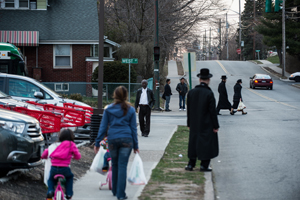 The central issue of this otherwise minor election is a rephrasing of the question that animates politics here: where is the line that separates the public from the private.
The central issue of this otherwise minor election is a rephrasing of the question that animates politics here: where is the line that separates the public from the private.
In recent years, the school board here has been dominated by members of the Hasidic community. Since taking control, the board has gutted the public school system, leaving the mostly black and Latino students with fewer classes, no after school programs and no extra curricular activities or clubs.
The most recent budget has called for even deeper cuts in an already devastated system. The public school community has said the Hasidic board exploits laws to redirect public money into yeshivas, where their children go for religious and cultural reasons.
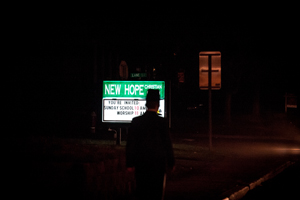 Leaders of the Hasidic community say that the allegations that the religious dominated board redirects the money from public school children to the yeshivas is false.
Leaders of the Hasidic community say that the allegations that the religious dominated board redirects the money from public school children to the yeshivas is false.
“The biggest misconception that we have here is that we’re sticking our hands into the pockets of the public school kids and putting it in our childrens’ pockets,” Yehuda Weissmandl, a Hasidic Jew who assumed leadership of the school board when his predecessor abruptly resigned last month, recently said. “That is not true and it is offensive. I give away a lot of time to these children, time I should be spending with my children because I’m very passionate about these children.”
The election also comes as many in the area fear that the deep cuts are leading to a public safety crisis, one where teens will end up in the criminal justice system instead of school.
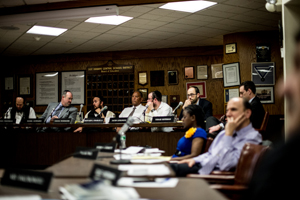 Dr. Oscar Cohen, an advocate for public school children who has worked with the Spring Valley NAACP, said the same vitriol that has marked the feud between the public school advocates and the members of the Hasidic community has defined the campaign for the seats on the board.
Dr. Oscar Cohen, an advocate for public school children who has worked with the Spring Valley NAACP, said the same vitriol that has marked the feud between the public school advocates and the members of the Hasidic community has defined the campaign for the seats on the board.
“Anger,” he said. “That is the prevailing force here. It is effecting everything.”
This election is unusual because it is the first time in years that none of the candidates for the three contested seats are from the Ultra Orthodox community, but they are backed by it.
Arthur Schwartz, one of the lead attorneys on a class action lawsuit challenging the practices of the Orthodox-dominated school board, described what he called the ‘Charles slate’ as “cosmetic.” This slate includes: Bernard Charles, a black interim member of the board; Pierre Germain, a Haitian American, and MaraLuz Corado, a Latina pastor.
“I don’t know if this is going to fool a lot of black or Hispanic people,” he said. “There are people who are willing to sell out their brethren, so to speak, in return for power and positions.”
Schwartz said that although there are more registered public school voters, the Hasidim have a bigger turnout because they are effective at mobilizing turnout.
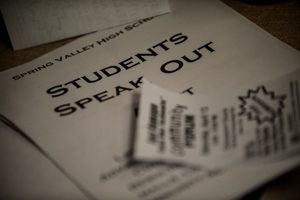 Charles did not return phone calls for comment on this story. Gov. Andrew Cuomo’s press office did not respond to calls and emails.
Charles did not return phone calls for comment on this story. Gov. Andrew Cuomo’s press office did not respond to calls and emails.
Cohen agreed with Schwartz’s assessment, saying that the lack of a slate of Hasidic candidates is in appearance only.
“At the end of the election you are going to have nine members on the board, six from the orthodox community, and three that will vote the way the orthodox community tells them to vote,” he said. “Nothing is going to change. Nothing.”
The public school slate of candidates for the East Ramapo School Board — Robert Forrest, Margaret Tuck and Eustache Clerveaux — accepted the invitation from the local NAACP leadership to field questions at the meeting. But Charles’ opposing slate declined without an explanation.
The night of the forum, while they talked to an audience of some 125 black and Latino parents about how they would look out for the interests of the public school children, Charles was spotted at a local ballpark where members of the Hasidic community were hosting an event on the dangers of the Internet.
He was handing out campaign fliers in Yiddish.
Photo credit: all images by John Stolarik / JJIE.





























